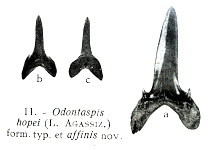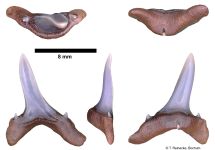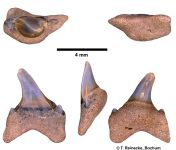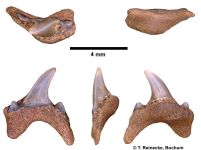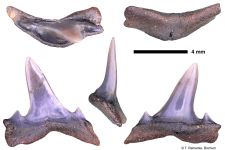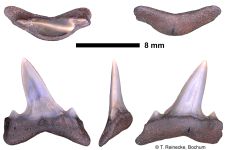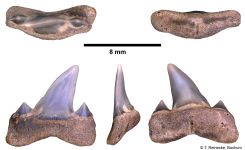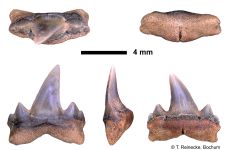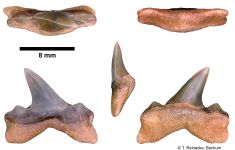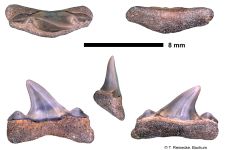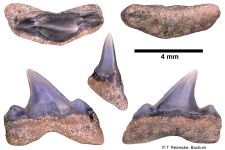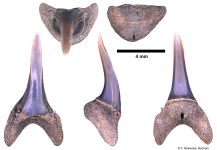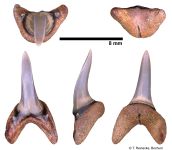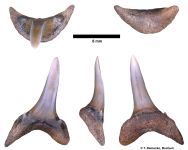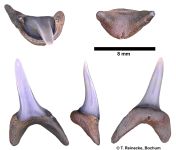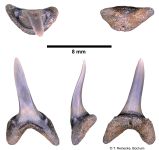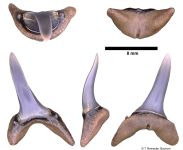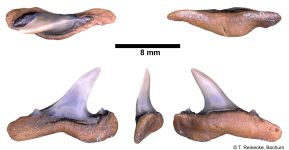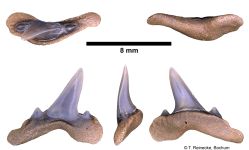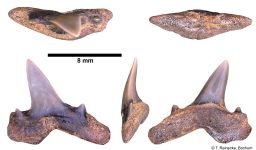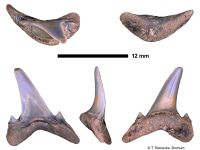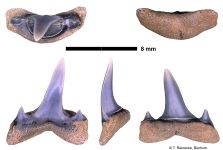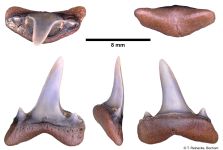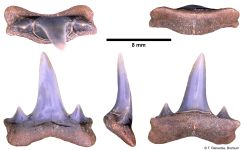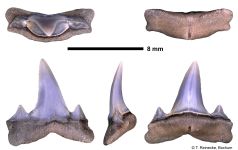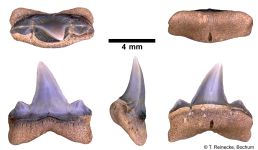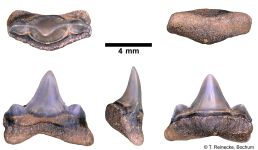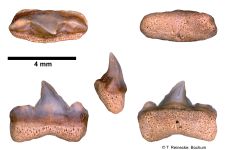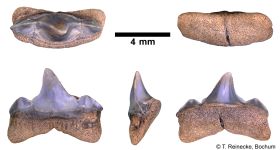Isurolamna affinis
(Casier, 1946)
Classification: Elasmobranchii Lamniformes Lamnidae
Reference of the original description
La faune ichthyologique de l'Yprésien de la Belgique. Mémoires du Musée Royal d'Histoire Naturelle de Belgique, 104, 1–267
La faune ichthyologique de l'Yprésien de la Belgique. Mémoires du Musée Royal d'Histoire Naturelle de Belgique, 104, 1–267
Synonyms / new combinations and misspellings
Isurolamna hopei affinis, Lamiostoma affinis, Lamna affinis, Odontaspis hopei affinis, Odontaspis (Synodontaspis) affinis, Odontaspis (Synodontaspis) hopei affinis
Isurolamna hopei affinis, Lamiostoma affinis, Lamna affinis, Odontaspis hopei affinis, Odontaspis (Synodontaspis) affinis, Odontaspis (Synodontaspis) hopei affinis
Description:
Citation: Isurolamna affinis (Casier, 1946): In: Database of fossil elasmobranch teeth www.shark-references.com, World Wide Web electronic publication, Version 12/2025
Please send your images of "Isurolamna affinis" to info@shark-references.com
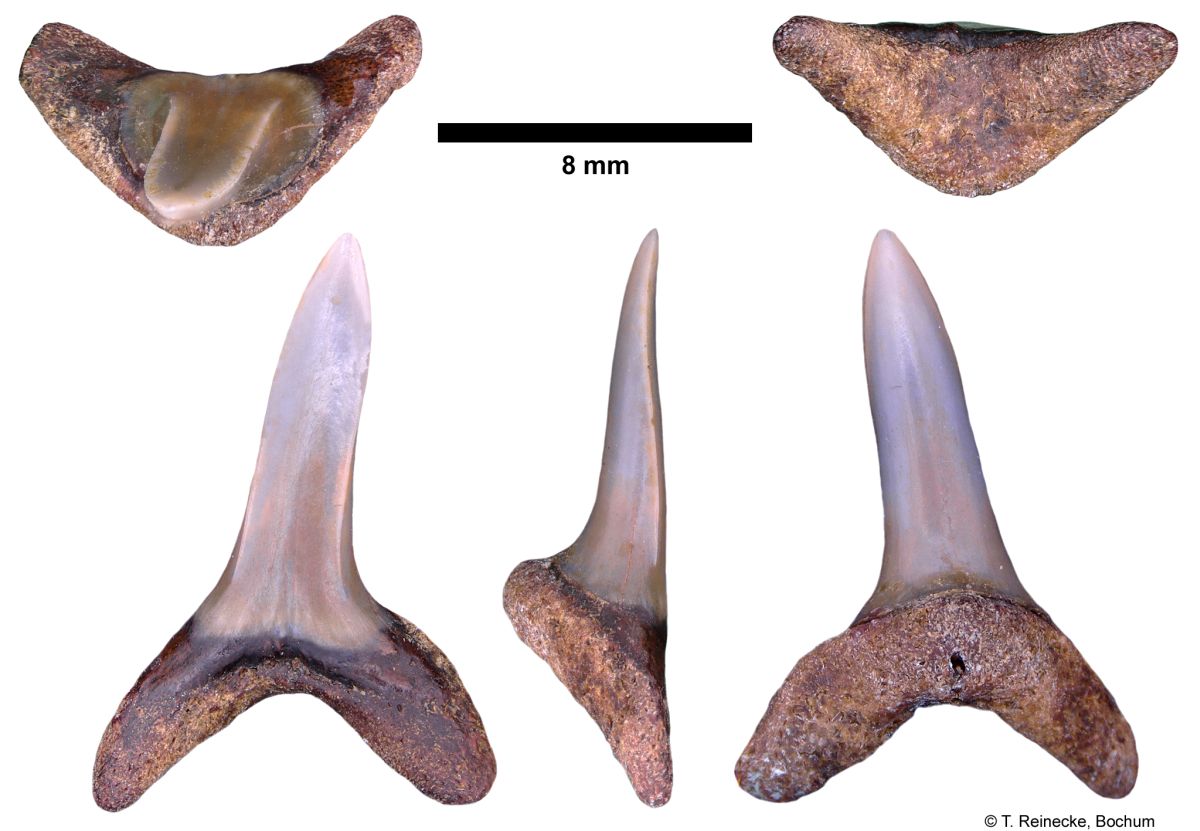
Isurolamna affinis (Casier, 1946); London Clay Formation, Division D, Sheppey Member, Ypresian, early Eocene; Cliff Reach, Burnham-on-Crouch, Essex, UK; © T. Reinecke, Bochum

Isurolamna affinis (Casier, 1946); London Clay Formation, Division D, Sheppey Member, Ypresian, early Eocene; Cliff Reach, Burnham-on-Crouch, Essex, UK; © T. Reinecke, Bochum
Description
Original diagnosis after Casier (1946) p. 65 [411]: 4. Horizon inconnu (probablement Sables à Nummulites planulatus); localités : Ellezelles, Maulde, Mons (Mont Panisel), Renaix, Uccle.
Plésiotype n ° 223. Cat. types Poiss. foss. M.R.H.N .B. (l.G. n ° 13.488) (PL II, fig. 11 a).
Holotype (var. affinis) n° 224. Cal. id. (I.G. n° 13.468) (Pl. II, fig. 11 b-c).
Cette espèce, l'une des plus communes de l'Éocène du bassin anglo-francobelge, est représentée dans le matériel étudié par une série imposante de dents isolées, en moyenne sensiblement inférieures en taille à celles recueillies dans les terrains plus récents de Belgique. A ce point de vue, on peut considérer la dent figurée ici sous le n° 11 a de la planche II comme exceptionnellement grande pour l'Yprésien.
Comme toutes les espèces très répandues, celle-ci se montre d'ailleurs polymorphe : l'importance des denticules latéraux, parfois insignifiants, d'autres fois importants et unciformes, comme dans le cas de la dent précitée, est essentiellement sujette à variations. Beaucoup de dents latérales présentent même un dédoublement de ces denticules.
D'autres fois, la couronne se cintre à la base par rapprochement de ses deux bords, caractère qui s'accompagne d'un épaississement notable de la racine, en même temps que d'une réduction de l'importance des denticules latéraux et du sillon postérieur.
Cette dernière forn1e de dents, dont j'ai également observé l'existence dans le Bruxellien (Lutétien inférieur), semble bien devoir être distinguée à titre de variété (affinis n. var.) (Pl. II, fig. 11 b-c). Le caractère remarquable des dents de celle-ci est la taille insignifiante des denticules latéraux, opposée au développement énorme de la racine (on distingue à peine ces denticules sur la figure 11 b représentant une dent antérieure vue par la face externe et ils sont totalement masqués par la racine sur la figure 11 c, montrant. la même dent vue par sa face interne).
Original diagnosis after Casier (1946) p. 65 [411]: 4. Horizon inconnu (probablement Sables à Nummulites planulatus); localités : Ellezelles, Maulde, Mons (Mont Panisel), Renaix, Uccle.
Plésiotype n ° 223. Cat. types Poiss. foss. M.R.H.N .B. (l.G. n ° 13.488) (PL II, fig. 11 a).
Holotype (var. affinis) n° 224. Cal. id. (I.G. n° 13.468) (Pl. II, fig. 11 b-c).
Cette espèce, l'une des plus communes de l'Éocène du bassin anglo-francobelge, est représentée dans le matériel étudié par une série imposante de dents isolées, en moyenne sensiblement inférieures en taille à celles recueillies dans les terrains plus récents de Belgique. A ce point de vue, on peut considérer la dent figurée ici sous le n° 11 a de la planche II comme exceptionnellement grande pour l'Yprésien.
Comme toutes les espèces très répandues, celle-ci se montre d'ailleurs polymorphe : l'importance des denticules latéraux, parfois insignifiants, d'autres fois importants et unciformes, comme dans le cas de la dent précitée, est essentiellement sujette à variations. Beaucoup de dents latérales présentent même un dédoublement de ces denticules.
D'autres fois, la couronne se cintre à la base par rapprochement de ses deux bords, caractère qui s'accompagne d'un épaississement notable de la racine, en même temps que d'une réduction de l'importance des denticules latéraux et du sillon postérieur.
Cette dernière forn1e de dents, dont j'ai également observé l'existence dans le Bruxellien (Lutétien inférieur), semble bien devoir être distinguée à titre de variété (affinis n. var.) (Pl. II, fig. 11 b-c). Le caractère remarquable des dents de celle-ci est la taille insignifiante des denticules latéraux, opposée au développement énorme de la racine (on distingue à peine ces denticules sur la figure 11 b représentant une dent antérieure vue par la face externe et ils sont totalement masqués par la racine sur la figure 11 c, montrant. la même dent vue par sa face interne).
Remarks
shark-references Species-ID=3218;
Taxonomic remark: Casier (1946) pl. 2, fig. 11 a = Hypotodus verticalis, pl. 2, fig. 11 b-c = Isurolamna affinis see: Cappetta & Nolf (2006) p. 245 [366]: En 1946, Casier a créé une variété, nouvelle, d'Odontaspis hopei, nommée affinis; le matériel type de cette variété est en fait hétérogène. Le paratype (= plésiotype de Casier), une dent antérieure d'assez grande taille (1946, pl. 2, fig. 11 a), correspond à une dent latéro-antérieure inférieure de l'espèce verticalis. L'holotype par contre (pl. 2, fig. 11 b-c) appartient à une espèce bien différente de lamniforme attribuée depuis au genre Isurolamna (voir Cappetta, 1976 [323]).
Taxonomic remark after Cappetta & Case, 2016 [24889]: Isurolamna inflata was erected by Leriche (1905) [1425], as a variety of Lamna vincenti (Winkler, 1876) [2576], on the basis of teeth coming from many Lutetian localities of Belgium, but no type specimen was designated nor figured at this time. In fact, this species seems morphologically close to I. affinis (Casier, 1946) [411] and only a serious revision of material from Thanetian to Lutetian could allow to clarify the systematics and relationships of those species.
shark-references Species-ID=3218;
Taxonomic remark: Casier (1946) pl. 2, fig. 11 a = Hypotodus verticalis, pl. 2, fig. 11 b-c = Isurolamna affinis see: Cappetta & Nolf (2006) p. 245 [366]: En 1946, Casier a créé une variété, nouvelle, d'Odontaspis hopei, nommée affinis; le matériel type de cette variété est en fait hétérogène. Le paratype (= plésiotype de Casier), une dent antérieure d'assez grande taille (1946, pl. 2, fig. 11 a), correspond à une dent latéro-antérieure inférieure de l'espèce verticalis. L'holotype par contre (pl. 2, fig. 11 b-c) appartient à une espèce bien différente de lamniforme attribuée depuis au genre Isurolamna (voir Cappetta, 1976 [323]).
Taxonomic remark after Cappetta & Case, 2016 [24889]: Isurolamna inflata was erected by Leriche (1905) [1425], as a variety of Lamna vincenti (Winkler, 1876) [2576], on the basis of teeth coming from many Lutetian localities of Belgium, but no type specimen was designated nor figured at this time. In fact, this species seems morphologically close to I. affinis (Casier, 1946) [411] and only a serious revision of material from Thanetian to Lutetian could allow to clarify the systematics and relationships of those species.
References

Fossil chondrichthyans of the Carpathian-Pannonian Region (in Hungarian: A Kárpát-Pannon-térség fosszilis porcoshalai). Hungarian Natural History Museum, Dabasi Nyomda Zrt., Budapest. 255 pages, ISBN 978-963-9877-52-8
Middle Eocene cartilaginous fishes (Vertebrata: Chondrichthyes) of the Dnieper–Donets Basin, northern Ukraine. Palaeontologia Electronica, 26(2), Article a32
Feeding ecology has shaped the evolution of modern sharks. Current Biology, 31(23), 5138–5148
DOI: 10.1016/j.cub.2021.09.028

A mesopelagic selachian fauna from the middle Eocene of St. Pankraz (Austria) reveals homogeneity in deep-marine environments during the warm period in Europe. Neues Jahrbuch für Geologie und Paläontologie, Abhandlungen, 301(1), 25–63
DOI: 10.1127/njgpa/2021/0996

Climate cooling and clade competition likely drove the decline of lamniform sharks. Proceedings of the National Academy of Sciences of the United States of America, 116(41), 20584–20590
DOI: 10.1073/pnas.1902693116
A study of the sharks and rays from the Lillebælt Clay (Early–Middle Eocene) of Denmark, and their palaeoecology. Bulletin of the Geological Society of Denmark, 62, 39–88
DOI: 10.37570/bgsd-2014-62-04

The Aktulagay section, west Kazakhstan: a key site fornorthern mid-latitude Early Eocene stratigraphy. Stratigraphy, 10(3): 171–209
Quantitative analysis of Elasmobranch assemblages from two successive Ypresian (early Eocene) facies at Marke, western Belgium. Geologica Belgica, 15(3), 146–153
Eocene (Lutetian) Shark-Rich Coastal Paleoenvironments of the Southern North Sea Basin in Europe: Biodiversity of the Marine Fürstenau Formation Including Early White and Megatooth Sharks. International Journal of Oceanography, 2012, Article ID 565326
DOI: 10.1155/2012/565326
Inventaire systématique des Invertebrata, Vertebrata, Plantae et Fungi des Sables de Bruxelles. Geominpal Belgica Découvertes géologiques, minéralogiques et paléontologiques en Belgique, 1(2): 35–65

Surface-water freshening and high-latitude river discharge in the Eocene North Sea. Journal of the Geological Society, 166, 969–980
DOI: 10.1144/0016-76492008-068

The Elasmobranch Fauna of the Lede Sand Formation at Oosterzele (Lutetian, Middle Eocene of Belgium). Palaeofocus, 1, 1–57
Contribution of Eocene sharks and rays from southern France to the history of deep-sea selachians. Acta Geologica Polonica, 58(2), 257–260

Nouvelles faunes de sélaciens (Elasmobranchii, Neoselachii) de l'Éocène des Landes (Sud-Ouest, France). Implication dans les connaissances des communautés d'eaux profondes. Palaeo Ichthyologica, 10, 1–128

Report of Field Meeting to Burnham-on-Crouch, Essex. Tertiary Research, 22(1-4), 89–92

Fossil Shark Teeth of the World. Lamna Books, 170 p

London Clay Fossils of the Isle of Sheppey. Medway Lapidary and Mineral Society, ISBN 0-9538243-0-6, 100pp.

Les élasmobranches fossiles du Paléogène des Landes (Sud-Ouest, France). Implications dans la connaissance des communautés d'élasmobranches d'eaux profondes. Evolution des Squaliformes et paléoécologie. 211 p., 23 fig., annexes, 40 pl. Dipl. Doct., Univ. Montpellier II.

Fossiele haaietanden uit het Tertiair van Cadzand. Grondboor & Hamer, 49(3/4), 51–53

Soortenlijst van fossiele vissen uit het Eoceen van België. Afzettingen WTKG, 15(4), 6–12

Haie, Rochen und Chimären aus dem mitteloligozänen Meeressand von Leipzig. Aufschluss, 43(4), 195–214

A checklist of Neoselachii (Pisces, Chondrichthyes) from the Palaeogene of the Paris Basin, France. Tertiary Research, 13(1) , 27–36

An Illustrated Guide to the British Middle Eocene Vertebrates. Privately published, London, 59 pp.

(Phylogenesis of Lamnoid sharks of the Palaeogene and their significance for zonal Stratigraphy in Phylogenetic aspects of palaeontology) «in russian». Academy of Sciences of the USSR, All–Union Palaeont. Soc.: 16–17


Fossiles de Belgique. Dents de Requins et de Raies du Tertiaire de la Belgique. Institut royal des Sciences naturelles de Belgique, 184 pp.

Stand der Untersuchungen an der Chondrichthyes-Fauna des nordwestdeutschen Tertiärs. Beiträge zur regionalen Geologie der Erde, 18, 503–509

Fossilfunde aus den Deckschichten des Helmstedter Braunkohlereviers. Aufschluss, 37(10), 343–349


Haaie- en Roggentanden uit het Tertiair van Belgie. Institut royal des Sciences naturelles de Belgique, 1–171

Die marinen Deckschichten (Mitteleozän-Unteroligozän) der Helmstedter Braunkohlen (Niedersachsen, BRD). Documenta naturae, 22, 1–120

Fossil sharks, rays and chimaeroids of the English Tertiary period. Gosport Museum, 1–47, 10 fig., 3 tabl., 16 pl.

The distribution of sharks, rays and chimaeroids in the English Palaeogene. Tertiary Research, 3(1), 13–19

Eine Lagerstätte kreidezeitlicher und paläogener Chondrichthyes-Reste bei Fürstenau (Niedersachsen). Osnabrücker Naturwissenschaftliche Mitteilungen, 6, 35–44

The palaeontology of the London Clay (Lower Eocene) of the Herne Bay coastal section, Kent, England. Proceedings of the Geological Association, 88(3): 163–178
DOI: 10.1016/S0016-7878(77)80025-4

Sélaciens nouveaux du London Clay de l'Essex (Yprésien du Bassin de Londres). Geobios, 9(5), 551–575
DOI: 10.1016/S0016-6995(76)80024-1

Haaietanden en andere fossielen uit de transgressielaag aan de basis van het Ledien bij Aalst. GEA, 6(1), 31–37

Faune ichthyologique du London Clay. Trustees of the British Museum: 496 pp., 82 fig., 68 pl.
Contributions à l'étude des poissons fossiles de la Belgique. IX. La faune des formations dites "paniséliennes". Bulletin de l'Institut Royal des Sciences Naturelles de Belgique, 26(42), 1–52

Fossil chondrichthyans of the Carpathian-Pannonian Region (in Hungarian: A Kárpát-Pannon-térség fosszilis porcoshalai). Hungarian Natural History Museum, Dabasi Nyomda Zrt., Budapest. 255 pages, ISBN 978-963-9877-52-8
Middle Eocene cartilaginous fishes (Vertebrata: Chondrichthyes) of the Dnieper–Donets Basin, northern Ukraine. Palaeontologia Electronica, 26(2), Article a32
Feeding ecology has shaped the evolution of modern sharks. Current Biology, 31(23), 5138–5148
DOI: 10.1016/j.cub.2021.09.028

A mesopelagic selachian fauna from the middle Eocene of St. Pankraz (Austria) reveals homogeneity in deep-marine environments during the warm period in Europe. Neues Jahrbuch für Geologie und Paläontologie, Abhandlungen, 301(1), 25–63
DOI: 10.1127/njgpa/2021/0996

Climate cooling and clade competition likely drove the decline of lamniform sharks. Proceedings of the National Academy of Sciences of the United States of America, 116(41), 20584–20590
DOI: 10.1073/pnas.1902693116
A study of the sharks and rays from the Lillebælt Clay (Early–Middle Eocene) of Denmark, and their palaeoecology. Bulletin of the Geological Society of Denmark, 62, 39–88
DOI: 10.37570/bgsd-2014-62-04

The Aktulagay section, west Kazakhstan: a key site fornorthern mid-latitude Early Eocene stratigraphy. Stratigraphy, 10(3): 171–209
Quantitative analysis of Elasmobranch assemblages from two successive Ypresian (early Eocene) facies at Marke, western Belgium. Geologica Belgica, 15(3), 146–153
Eocene (Lutetian) Shark-Rich Coastal Paleoenvironments of the Southern North Sea Basin in Europe: Biodiversity of the Marine Fürstenau Formation Including Early White and Megatooth Sharks. International Journal of Oceanography, 2012, Article ID 565326
DOI: 10.1155/2012/565326
Inventaire systématique des Invertebrata, Vertebrata, Plantae et Fungi des Sables de Bruxelles. Geominpal Belgica Découvertes géologiques, minéralogiques et paléontologiques en Belgique, 1(2): 35–65

Surface-water freshening and high-latitude river discharge in the Eocene North Sea. Journal of the Geological Society, 166, 969–980
DOI: 10.1144/0016-76492008-068

The Elasmobranch Fauna of the Lede Sand Formation at Oosterzele (Lutetian, Middle Eocene of Belgium). Palaeofocus, 1, 1–57
Contribution of Eocene sharks and rays from southern France to the history of deep-sea selachians. Acta Geologica Polonica, 58(2), 257–260

Nouvelles faunes de sélaciens (Elasmobranchii, Neoselachii) de l'Éocène des Landes (Sud-Ouest, France). Implication dans les connaissances des communautés d'eaux profondes. Palaeo Ichthyologica, 10, 1–128

Report of Field Meeting to Burnham-on-Crouch, Essex. Tertiary Research, 22(1-4), 89–92

Fossil Shark Teeth of the World. Lamna Books, 170 p

London Clay Fossils of the Isle of Sheppey. Medway Lapidary and Mineral Society, ISBN 0-9538243-0-6, 100pp.

Les élasmobranches fossiles du Paléogène des Landes (Sud-Ouest, France). Implications dans la connaissance des communautés d'élasmobranches d'eaux profondes. Evolution des Squaliformes et paléoécologie. 211 p., 23 fig., annexes, 40 pl. Dipl. Doct., Univ. Montpellier II.

Fossiele haaietanden uit het Tertiair van Cadzand. Grondboor & Hamer, 49(3/4), 51–53

Soortenlijst van fossiele vissen uit het Eoceen van België. Afzettingen WTKG, 15(4), 6–12

Haie, Rochen und Chimären aus dem mitteloligozänen Meeressand von Leipzig. Aufschluss, 43(4), 195–214

A checklist of Neoselachii (Pisces, Chondrichthyes) from the Palaeogene of the Paris Basin, France. Tertiary Research, 13(1) , 27–36

An Illustrated Guide to the British Middle Eocene Vertebrates. Privately published, London, 59 pp.

(Phylogenesis of Lamnoid sharks of the Palaeogene and their significance for zonal Stratigraphy in Phylogenetic aspects of palaeontology) «in russian». Academy of Sciences of the USSR, All–Union Palaeont. Soc.: 16–17


Fossiles de Belgique. Dents de Requins et de Raies du Tertiaire de la Belgique. Institut royal des Sciences naturelles de Belgique, 184 pp.

Stand der Untersuchungen an der Chondrichthyes-Fauna des nordwestdeutschen Tertiärs. Beiträge zur regionalen Geologie der Erde, 18, 503–509

Fossilfunde aus den Deckschichten des Helmstedter Braunkohlereviers. Aufschluss, 37(10), 343–349


Haaie- en Roggentanden uit het Tertiair van Belgie. Institut royal des Sciences naturelles de Belgique, 1–171

Die marinen Deckschichten (Mitteleozän-Unteroligozän) der Helmstedter Braunkohlen (Niedersachsen, BRD). Documenta naturae, 22, 1–120

Fossil sharks, rays and chimaeroids of the English Tertiary period. Gosport Museum, 1–47, 10 fig., 3 tabl., 16 pl.

The distribution of sharks, rays and chimaeroids in the English Palaeogene. Tertiary Research, 3(1), 13–19

Eine Lagerstätte kreidezeitlicher und paläogener Chondrichthyes-Reste bei Fürstenau (Niedersachsen). Osnabrücker Naturwissenschaftliche Mitteilungen, 6, 35–44

The palaeontology of the London Clay (Lower Eocene) of the Herne Bay coastal section, Kent, England. Proceedings of the Geological Association, 88(3): 163–178
DOI: 10.1016/S0016-7878(77)80025-4

Sélaciens nouveaux du London Clay de l'Essex (Yprésien du Bassin de Londres). Geobios, 9(5), 551–575
DOI: 10.1016/S0016-6995(76)80024-1

Haaietanden en andere fossielen uit de transgressielaag aan de basis van het Ledien bij Aalst. GEA, 6(1), 31–37

Faune ichthyologique du London Clay. Trustees of the British Museum: 496 pp., 82 fig., 68 pl.
Contributions à l'étude des poissons fossiles de la Belgique. IX. La faune des formations dites "paniséliennes". Bulletin de l'Institut Royal des Sciences Naturelles de Belgique, 26(42), 1–52








